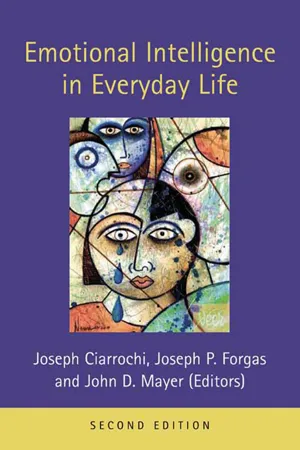
Emotional Intelligence in Everyday Life
- 312 pages
- English
- ePUB (mobile friendly)
- Available on iOS & Android
Emotional Intelligence in Everyday Life
About This Book
Since the release of the very successful first edition in 2001, the field of emotional intelligence has grown in sophistication and importance. Many new and talented researchers have come into the field and techniques in EI measurement have dramatically increased so that we now know much more about the distinctiveness and utility of the different EI measures. There has also been a dramatic upswing in research that looks at how to teach EI in schools, organizations, and families.In this second edition, leaders in the field present the most up-to-date research on the assessment and use of the emotional intelligence construct. Importantly, this edition expands on the previous by providing greater coverage of emotional intelligence interventions.As with the first edition, this second edition is both scientifically rigorous, yet highly readable and accessible to a non-specialist audience. It will therefore be of value to researchers and practitioners in many disciplines beyond social psychology, including areas of basic research, cognition and emotion, organizational selection, organizational training, education, clinical psychology, and development psychology.
Frequently asked questions
Information
| PART | |
| I | |
| FUNDAMENTAL ISSUES |
| 1 CHAPTER |
A New Field Guide to Emotional Intelligence
□ Introduction
□ A New Field Guide to Emotional Intelligence
□ How Did the Field Begin (and How Was It Popularized)?
| 1900–1969: Intelligence and Emotions as Separate, Narrow Fields | Intelligence research. The realm of psychological testing for intelligence was developed during this period and a sophisticated technology of intelligence tests arose (see [3] for a review). Emotions research. In the separate field of emotion, debate centered on the chicken-and-egg problem of which happens first: physiological reaction, or emotion. In other areas of work, Darwin had argued for the heritability and evolution of emotional responses, but during this time, emotion was often viewed as culturally determined, largely a product of pathology, and idiosyncratic (see [4] for a review of Darwin's work). The search for social intelligence. As intelligence testing emerged, the focus was on verbal and propositional intelligence. A number of psychologists sought to identify a social intelligence as well; however, efforts in this direction were discouraging and conceptions of intelligence remained cognitive. |
| 1970–1989: Precursors to Emotional Intelligence | Cognition and affect. The precursors to emotional intelligence were put into place in this two-decade period. The field of cognition and affect emerged to examine how emotions interacted with thoughts. Researchers suggested that depressed people might be more realistic and accurate than others and that mood swings might enhance creativity [5]. The field of nonverbal communication developed scales devoted to perception of nonverbal information—some of it emotional—in faces and posture [6]. Those in the field of artificial intelligence examined how computers might understand and reason about the emotional aspects of stories [7]. Multiple intelligences. Gardner [8] described an “intrapersonal intelligence,” which involved, among other things, the capacity to perceive and symbolize emotions. Social intelligence. For example, empirical work on social intelligence found that it divided into social skills, empathy skills, prosocial attitudes, social anxiety, and emotionality (sensitivity) [9]. Brain research began to separate out connections between emotion and cognition (e.g., [10]). Occasional use of the term, “emotional intelligence” was made [11], [12, pp. 103, 107]. |
| 1990–1993: The Emergence of Emotional Intelligence | The four-year period beginning the 1990s saw the first sustained development of the first concept of emotional intelligence. The article, “Emotional Intelligence” provided a first review of areas potentially relevant to an emotional intelligence. At the same time, a demonstration study, including the first ability measure of emotional intelligence under that name, was published. An editorial in the journal Intelligence argued for the existence of an emotional intelligence as an actual intelligence (see [13–15]). During this time, further foundations of emotional intelligence were developed, particularly in the brain sciences (e.g., [16]). |
| 1995–1997: The Popularization and Broadening of Emotional Intelligence | Goleman, a science journalist, published the popular book, Emotional Intelligence, loosely modeled on the academic writings in the area (see above). The book became a world-wide best seller and was widely copied. TIME Magazine used the term “EQ” on its cover. A number of personality scales were published under the name of emotional intelligence (e.g., [17–19]). |
| 1998-present: Research on and Institutionalization of Emotional Intelligence | A number of refinements to the concept of emotional intelligence took place, along with the introduction of new measures of the concept, and a growing number of peer-reviewed research articles on the topic. These have now become too numerous to enumerate. |
Table of contents
- Cover
- Half Title
- Title Page
- Copyright Page
- Table of Contents
- About the Editors
- List of Contributors
- List of Figures
- List of Tables
- Introduction
- Part I Fundamental Issues
- Part II Applications of Emotional Intelligence Research to Everyday Life
- Part III Integration and Conclusions
- Author Index
- Subject Index